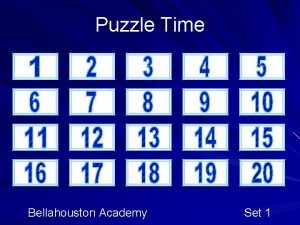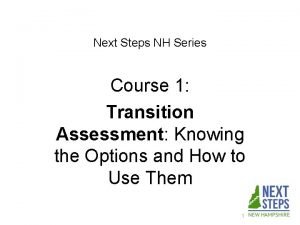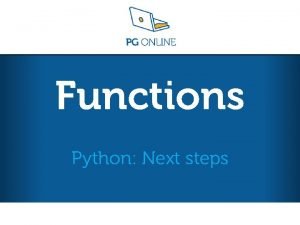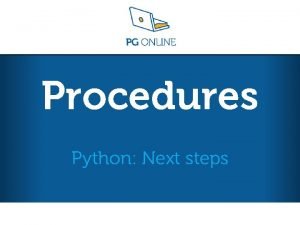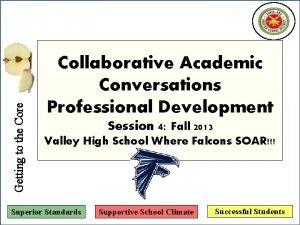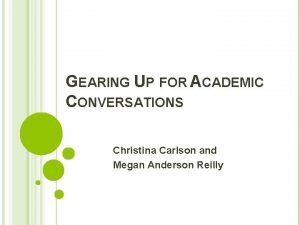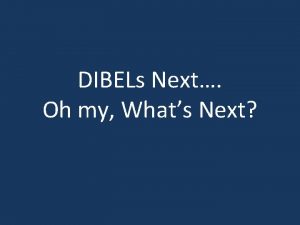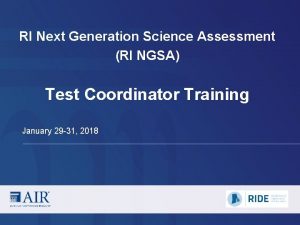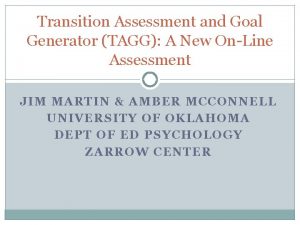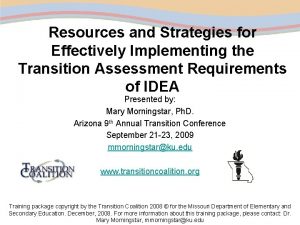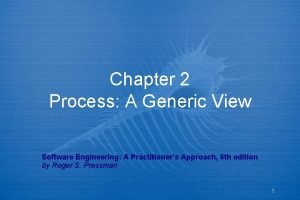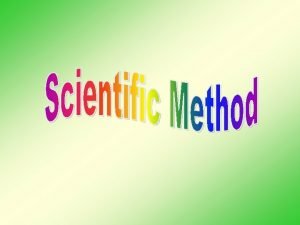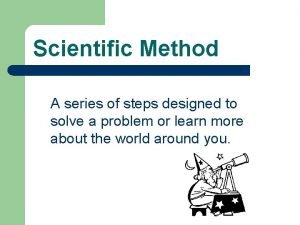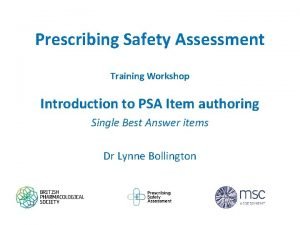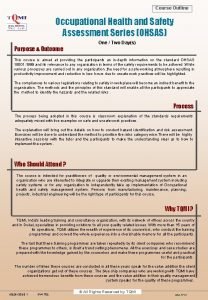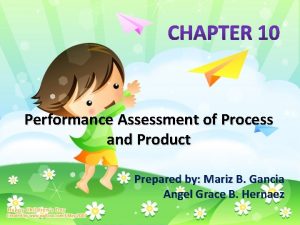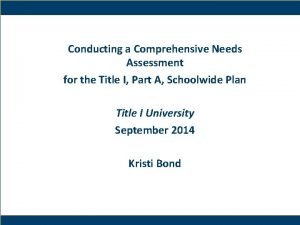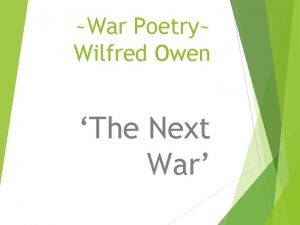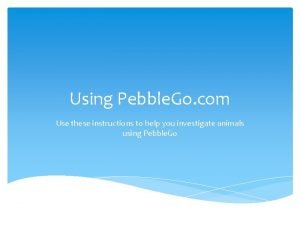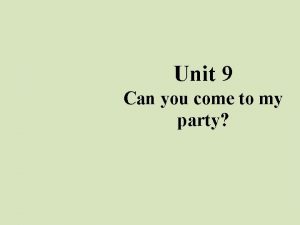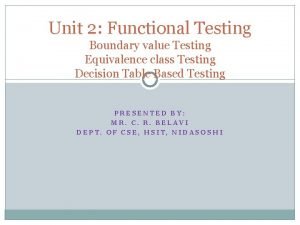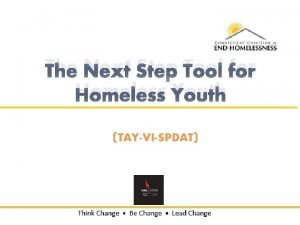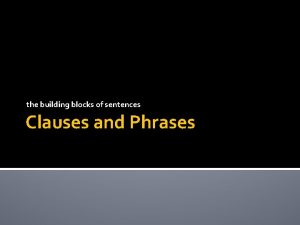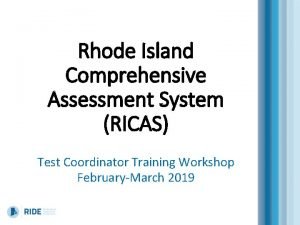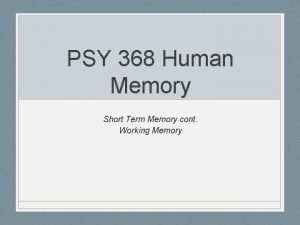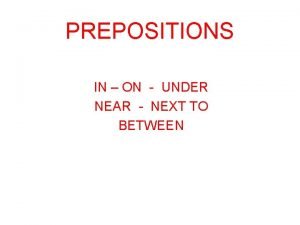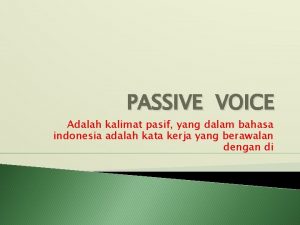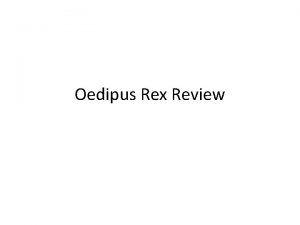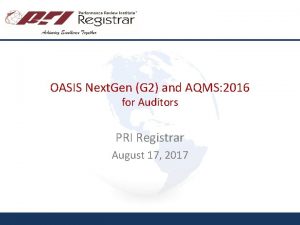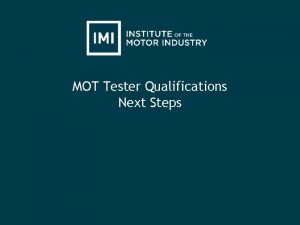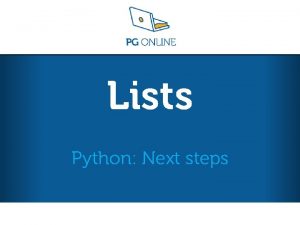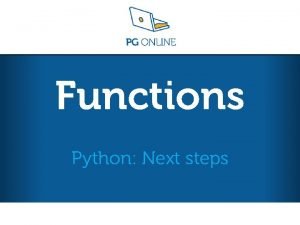Next Steps NH Series Course 1 Transition Assessment


















































- Slides: 50

Next Steps NH Series Course 1: Transition Assessment: Knowing the Options and How to Use Them 1

Making the Most of a G 2 M • • Muting & unmuting Using chat function Group activities Webcams

Learning Objectives In this session participants will: • Define transition assessment, • Learn about a variety of formal and informal transition assessments and procedures • Map current transition assessment • Determine actions for improving transition assessment practices. 3

Materials for Today • Slides • Jamerreo Transition Planning Worksheet • Transition Assessment Mapping Tool • Sample Instruments Handout • Sample Transition Procedures 4

NSNH Essentials Next Steps NH offers training and coaching on embedding evidence-informed transition practices in schools to increase the graduation rate of students with disabilities and students at-risk of dropping out and prepare them for college, career and adult life. Training introduces and illustrates the practice. Coaching supports putting the training to use.

NSNH Essentials Transition practices include: • Enhanced transition planning, activities & opportunities, including RENEW • Best practice Extended Learning Opportunities (ELOs) • High level family-school engagement Evidence shows that embedding new practices requires multi-stage implementation.

Family Engagement Student-Focused Planning Two-way communication Shared decision making Transition-related training opportunities Student Led IEPs RENEW Transition Assessment Student Development Transition. Focused Education Framework Best Practice ELOs Self-Determination RENEW Interagency Collaboration Community Services Colleges/Universities ELO Partners Program Structure Leadership Teams Ongoing Strategic Planning Policy and Procedure Transition Competencies for Staff Transition Coordinator ELO Board Adapted from Taxonomy for Transition Programming, Kohler, P. D. (1996) & NH Co. P Template for Secondary Transition & NH Standards for Family /School Partnerships

NSNH Essentials Implementing practices with fidelity is a primary focus. The use of planning tools ensures fidelity. Not In Place Partially In Place X In Place Critical Component of Practice Students-at-risk and students with IEPs participate meaningfully in the development of their post school goals. When implemented with fidelity these practices will increase the graduation rates of students with disabilities and students at-risk of dropping out and prepare them for college, career and adult life.

Putting the Pieces Together 2. INSTALLATION 1. EXPLORATION • Develop & Meet w/ Project Teams (Leadership – ELO – FEG – RENEW) • Complete Fidelity tools • Develop action plans • Participate in foundational trainings • RENEW student mapping • Pilot a high quality ELO, EI transition practices • Offer parent education SUSTAINABILITY Leadership, ELO, 4. FULL IMPLEMENTATION RENEW, Family • Processes & Engagement Teams procedures in place & 3. INITIAL IMPLEMENTATION • Implement action plans • Identify & address Program Structures challenges • Scale up ELOs, RENEW & Transition Practices • Integrate family-school partnership strategies • System recalibrated to accommodate & support new initiatives (Based on Dean Fixen et al & SWIFT)

What were the outcomes of your last Indicator 13 monitoring visit, with respect to transition assessment? Who was involved in that process? Does your Next Steps action plan have any priorities that are related to transition assessment? What are they? PRE-WORK REVIEW 10

Rules Individuals with Disabilities Education Act 2004 • When child turns 16 • Or younger if determined by IEP Team • Appropriate measurable postsecondary goals based upon age appropriate transition assessments • Goals in training/education, employment, and, where appropriate, independent living skills • Transition services (including courses of study) needed to reach goals NH RULES for the Education of Children With Disabilities: • at age 14, or younger if determined by the IEP team, • Anticipated Courses of Study section completed 11

Compliance to Best Practice • Compliance=Indicator 13 • Transition Assessment = Data about College, Career and Life Readiness • Best practice = – schoolwide practices inclusive of students in special ed and at-risk – Targeted and intensive practices when 12 needed

Defining Transition Assessment • The ongoing process of collecting data on the individual’s needs, preferences, and interests as they relate to the demands of current and future working, educational, living, and personal and social environments 13

Defining Transition Assessment • Assessment data serve as the common thread in the transition process • Forms the basis for defining goals and services to be included in the Individualized Education Program (CEC-DCDT, 1997) 14

Purpose of Transition Assessment v Make informed choices v Take charge of the transition process v Understand the skills needed for postschool environments 15

Transition Assessment Informs us about future: Employment Independent Living Education/ Training 16

Transition Assessment Gathers information about: • • • Self-Determination Skills Independent Living Skills Vocational Interests & Skills Career Exploration Skills Academic Skills 17

What Assessment Should I Choose? 2. Does the student have the skill, knowledge and behavior needed to reach his or her goals? 3. Does the student have all the information needed to fully understand his/her goals? 4. What is the best way to gather the needed information? 1. What is the student’s intended plan? What are the Post-Secondary Goals? 18

What is the student’s intended plan? What are their Post-Secondary Goals? What are they interested in? ACTIVITY: PART 1 19

TYPES OF TRANSITION ASSESSMENTS Formal and Informal 20

Types of Transition Assessments Formal: • To learn about a wide variety of skill levels in various areas (e. g. , vocational, academic, social) • Published tests: scores that compare students to others • A starting point 21

Types of Formal Assessments • • • Learning style inventories Academic achievement tests Adaptive behavior scales Aptitude tests Interest inventories 22

Types of Transition Assessments Informal: • Observing the student in various academic and work experiences • Talking with the student about likes and dislikes • Setting up experiences to allow the student to try something that may be of interest • Often teacher-made • Often does not result in a score 23

Types of Informal Assessments • Observation: watching or listening to an individual’s behavior and recording relevant information • Interviews/ Questionnaires: structured or unstructured conversations through questionand-answer format • Environmental Analysis: carefully examining the environment in which an activity normally occurs • Curriculum based assessments: taskanalysis, portfolio assessments, work sample analysis, criterion-referenced tests (Test, Aspel, & Everson, 2006 - Transition Methods for Youth with Disabilities) 24

How do you help students determine if they have the skill, knowledge and behavior needed to reach his or her goals? How do you help students determine if the have all the information needed to fully understand goals? ACTIVITY: PART 2 25

Compilations of Assessments • Next Steps NH website: Nextstep-nh. org • NSTTAC Transition Assessment Toolkit http: //transitionta. org/sites/default/files/Transition Assessment. Toolkit. pdf • Transition Coalition Assessment Reviews http: //transitioncoalition. org/tc-assessmentreviews/? cat_ID=48 26

Self-Determination Assessments 27

AIR Self-Determination Assessment Formal Self-Determination Assessment v. Parent, Teacher Version, and Student Version v. Available at: Øwww. ou. edu/zarrow/sdetermination. html v. Cost: free 28

AIR Self-Determination Assessment 1 THINGS MY CHILD DOES Never 2 3 Almost Sometimes Never 4 5 Almost Always 1. My child knows what (s)he needs, likes, and is good at. 1 2 3 4 5 2. My child sets his or her own goals to satisfy wants or needs. (S)he thinks about his or her own abilities when setting goals. 1 2 3 4 5 29

I’m Determined Informal Transition Assessment • Virginia Department of Education Self. Determination Project website • Self-determination Student Checklist • http: //www. imdetermined. org/files_resource s/109/selfdeterminationcheckliststudentselfassessment. pdf • Free • LOTS of other GREAT STUFF to assist student and team in self-directed future planning. 30

Independent Living Skills Assessments 31

Vineland Adaptive Behavior Scale Formal Transition Assessment v. Norm-referenced Assessment v. Use the search functions at: http: //www. pearsonassess. ca/ v. Ages birth to 90 v. Range of options, starting at: $117. 00 32

Vineland Adaptive Behavior Scale Domain & Index Subdomain Communication Receptive Expressive Written Daily Living Skills Personal Domestic Community Socialization Interpersonal Relationships Play and Leisure Time Coping Skills Motor Skills Fine Gross Maladaptive Behavior Index (Optional) Internalizing Externalizing Other 33

The Life Skills Inventory • • Independent Living Skills Assessment Tool Identify if individual is prepared with the appropriate life skills to live independently. 15 different categories; 4 levels of accomplishment; requirements for moving on to the next level. http: //www. sped. sbcsc. k 12. in. us/PDF%20 Files/tassessments/Independent%20 Living /Life%20 Skills%20 Inventory_Independent %20 Living. pdf FREE!! 34

Casey Life Skills • Web based and FREE!!! • Spanish or English, with numerous supplemental assessments • Youth and caregiver formats • Automatically scored and sent to you • Can obtain class summaries • Provides different levels of questions for students across functioning levels • http: //lifeskills. casey. org/ 35

Teacher-made Independent Living Skills Survey Informal Transition Assessment v Teacher-made v Questionnaire or survey v Free Interviews and Questionnaires Observation Ecological Surveys Curriculumbased Assessmen t Functional Assessme nt 36

Teacher-made Independent Living Skills Survey Informal Assessment of Independent Living Skills Date: __________ Student: _______________ Area Outcome Questions Which one means having fun? Response Leisure Work School Live Outcome Which one is about having a job? Leisure School Outcome Which one is about learning? Leisure Work School Live Outcome Which one is about where you will live? Leisure School 37 Work Live

Vocational/ Career Exploration Assessments 38

Brigance Transition Skills Inventory Formal Transition Assessment v Middle and high school students v TSI Kit $259. 00 v Transition Skills Inventory $199. 00 v TSI Record Books 10 -Pack $35. 00 v www. curriculumassociates. com 39

Brigance Transition Skills Inventory Formal Transition Assessment • • • • Pre-employment/functional writing Career awareness Job-seeking Post-secondary opportunities Functional reading Speaking and listening Math Money and finance Technology Housing Food and clothing Health Travel and transportation Community resources 40

YES! (Your Employment Selections) Informal Transition Assessment v. Reading free, video based job preference program v. Videos for 120 jobs ØAccessed by characteristics or job choices ØMatched to training and qualifications v. Can access from CD ($395) or web ($20 person for 3 months) vwww. yesjobsearch. com 41

Common Informal Transition Assessments used in NH • Extended Learning Opportunities & Work. Based Learning – Student Reflection – Employer/Community Member Reflections • Student Centered Mapping – Intensive – First stage of RENEW 42

What else do you want to do? ACTIVITY PART 3 43

Transition Assessment HOW TO USE IT 44

How to Use It • The Common Thread • Transition-Focused IEPs – Summarized in present level sections. – Used when writing Measurable postsecondary goals, transition services and annual goal • Orient new staff with this training @Nextsteps-nh. org under resources) • Seek further training at The Iris Center or Transition Coalition (free!) 45

46

How to Use It • Develop departmental procedures • Program Development – Work-based learning opportunities – Guest interviewers, Information interviewing, Job shadows/trials, interactive career fairs • Use transition data to build personalized alternative learning pathways that include ELOs 47

Action Planning Select an aspiration, one that is achievable. ACTIVITY PART 4 48

Post-test! 49

Thank You! The contents of this presentation were developed under a grant from the US Department of Education, H 323 A 120003. However, those contents do not necessarily represent the policy of the US Department of Education, and you should not assume endorsement by the Federal Government. Project Officer, Corinne Weidenthal. This product is public domain. Authorization to reproduce it in whole or in part is granted. While permission to reprint is not necessary, the citation should be: NH State Personnel Development Grant – Next Steps NH (2012 -2017). New Hampshire Department of Education, Concord.
 X.next = x.next.next
X.next = x.next.next Cygtnlit
Cygtnlit Brigance transition skills inventory
Brigance transition skills inventory Macmillan next steps
Macmillan next steps Python next steps
Python next steps What is a procedure python
What is a procedure python Next steps with academic conversations
Next steps with academic conversations Next steps with academic conversations
Next steps with academic conversations T junction brick wall
T junction brick wall Course title and course number
Course title and course number Chaine parallèle muscle
Chaine parallèle muscle Dibels next benchmark goals
Dibels next benchmark goals Ngsa tide
Ngsa tide Transition assessment and goal generator
Transition assessment and goal generator Wan transition assessment
Wan transition assessment Maclaurin series vs taylor series
Maclaurin series vs taylor series Balmer series lyman series
Balmer series lyman series Serie de taylor
Serie de taylor Maclaurin polynomial
Maclaurin polynomial Ibm p series models
Ibm p series models General feedback structure
General feedback structure Series aiding and series opposing
Series aiding and series opposing Arithmetic series vs geometric series
Arithmetic series vs geometric series Generic view of process
Generic view of process Involves a series of steps
Involves a series of steps A series of steps designed to solve a problem
A series of steps designed to solve a problem Locomotor skills in dancing
Locomotor skills in dancing Prescribing safety assessment course
Prescribing safety assessment course Occupational health and safety course outline
Occupational health and safety course outline Identify the performance process and product
Identify the performance process and product Community needs assessment steps
Community needs assessment steps What is documentation portfolio
What is documentation portfolio Static assessment vs dynamic assessment
Static assessment vs dynamic assessment Portfolio assessment matches assessment to teaching
Portfolio assessment matches assessment to teaching The next war poem
The next war poem Vray
Vray Pebble go next
Pebble go next Can ___________ come to my party?
Can ___________ come to my party? Decision table for next date problem
Decision table for next date problem Next step tool
Next step tool Who lives next door to rob independent or dependent
Who lives next door to rob independent or dependent Excitation table for sr flip flops
Excitation table for sr flip flops Hn next gen
Hn next gen Ricas pearson support
Ricas pearson support Next in line effect psychology definition
Next in line effect psychology definition Under next to between
Under next to between The court will try the case next week passive voice
The court will try the case next week passive voice Palo alto networks next generation security platform
Palo alto networks next generation security platform Who does creon tell oedipus to send for?
Who does creon tell oedipus to send for? Oasis next gen
Oasis next gen Next gen hrms
Next gen hrms

